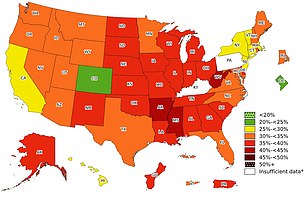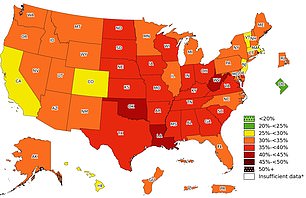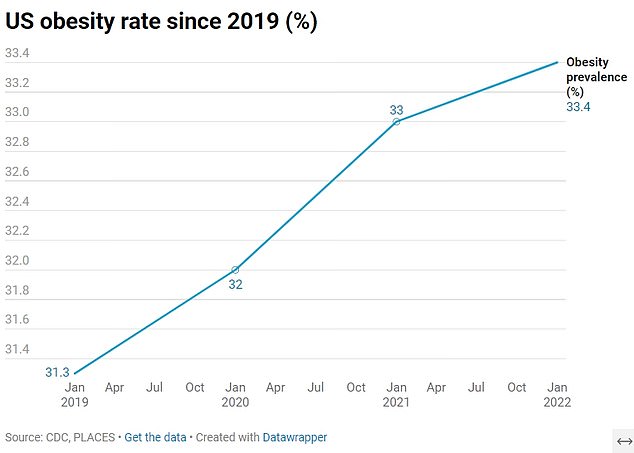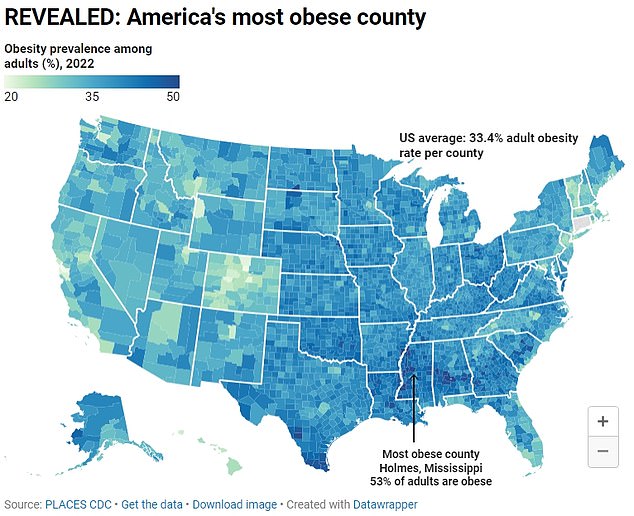The obesity problem in the United States is growing and is disproportionately affecting one region of the country.
The southern United States is home to 90 of the 100 counties with the highest obesity rates in the country, and the 15 with the highest obesity rates.
Overall, 33.4 percent of American adults are obese, a CDC report found, while separate figures suggest rates among children are as high as 17 percent.
The CDC’s recent report found that levels had barely increased in 2022 from 33 percent the previous year, but experts are expressing more concern about areas of the country where nearly half of residents are obese.
In the country’s roughly 3,000 counties, one-third — or 1,098 — currently have obesity rates above 40 percent among adults.
And in 11 counties, estimates suggest more than half of adults are now obese, a jump from eight counties the previous year.
The map above shows the obesity rate by county in the US (map created by DailyMail.com)
The findings come from CDC’s PLACES report, Population-Level Analysis and Community Estimates, released this month, which was based on more than 400,000 interviews conducted with a nationally representative group.
Of the 11 counties where obesity rates exceed 50 percent, six are spread across Mississippi, a state famous for its love of Southern fried food and where access to health care is limited.
It’s also the least active state in the US, according to Apple Watch data, with just 38.5 percent of residents getting the recommended minimum of 150 minutes of exercise each week.
Three other counties with a majority of obese people are in neighboring Alabama, while there is one each in Arkansas and Louisiana.
By county, Holmes County in Mississippi was the heaviest in the United States: an estimated 53 percent of adults are obese.
Jefferson County, also in Mississippi, ranked third at 52 percent, followed by Phillips County in Arkansas, East Carroll County in Louisiana and Claiborne County in Mississippi, all at about 51 percent.
Mississippi’s obesity problem has been worsening for more than a decade.
In 2011, Holmes County natives said National Public Radio that obesity rates had become so severe that 10-year-olds had diabetes, while 26-year-olds were suffering strokes.
They said even the school bus was starting to report overcrowding, and not because of an increase in people.
Calvin Head, a former county transportation director, said: “This was because the children had become very obese. There was no longer room for three children per seat. In most cases, you could only have two children per seat.”
In the most obese states in the United States, rates of obesity-related diseases such as heart disease and diabetes tend to be higher than in their leaner counterparts.
Life expectancy also tends to be lower: Mississippi has the lowest life expectancy in the country, at 71 years.
At the other end of the scale, San Francisco County in California was the least obese in the United States: only an estimated 18 percent of its residents were obese.
Boulder, Colorado, ranked second at nearly 19 percent, and Alameda, California, ranked third at 19.4 percent.
San Francisco and the Bay Area are considered among the most active and healthy cities in the U.S., and a 2022 analysis ranks California as the healthiest in the country.
In Colorado, residents are very active and participate in exercise and outdoor activities, such as hiking or skiing.


The maps above, from an independent report, show the obesity rate in 2023 (left), the latest available, and that of 2022, the previous year.

This chart shows how the US obesity rate has changed since 2019 according to the CDC’s PLACES report
Doctors have repeatedly raised concerns about obesity, warning that it puts people at risk of long-term health problems such as heart disease and even cancer.
The report comes just after the CDC released separate estimates showing the United States is now fatter than ever.
Estimates show that before 2013, no state had an adult obesity prevalence equal to or greater than 35 percent.
But by 2023, the latest date available, 23 states have reached the alarming threshold.
A record four states (West Virginia, Mississippi, Arkansas and Louisiana) now have obesity rates above 40 percent.
CDC Director Karen Hacker said: ‘These new data highlight the need for obesity prevention and treatment options that begin with building healthier communities where people of all ages have safe places to be physically active.
“And where health care and healthy eating options are accessible and affordable for all.”
She added: “Preventing obesity at an early age is critical because we know that obese children often become obese adults.”
While obesity is affecting nearly every corner of the country, experts hope that the arrival of hunger-suppressing drugs such as Ozempic could reverse the obesity epidemic in the United States.
But with only a month’s supply priced at about $900 out-of-pocket, the drugs are unlikely to have an impact where they are most needed.


